For more than two decades, Rocamador Rubio has been an integral part of the Trade Commission of Spain in Miami, FL, focusing primarily on the Building Materials and Furnishings sectors. Holding the title of director of the department of ceramic tile, natural stone, building materials and furnishings, she is a senior trade and promotion specialist.
During her tenure at the Trade Commission, Rubio has implemented many initiatives to promote Spanish tile in the U.S. Among her most successful, as well as close to her heart, is the Passport to Creativity Tour – an annual voyage to Spain to attend Cevisama, tour ceramic tile factories and emerge participants into Spanish history and culture. Stone & Tile Insider (S&TI) has had the privilege to join the tour for many years, and it always is a unique and eye-opening experience to learn about current trends and new technology.
Rubio, who has worked with people around the world and mentored numerous young industry professionals, took some time to share her experiences of working with the Trade Commission of Spain and talk about her mission to educate specifiers and distributors on Spanish tile.
S&TI: You have been with the Trade Commission of Spain for more than two decades. How did you first get involved with this organization?
RR: That is correct. I have been with the Trade Commission of Spain in Miami, FL, since April 2001. Before that, I was at the Trade Commission of Spain in Sao Paulo, Brazil, for almost six years.
My work for the Trade Commissions started with an internship in the Sao Paulo office in 1996. During that time, ICEX, the organization in Spain that promotes the internalization and investments of Spanish companies abroad, was organizing ExpoTécnia, one of the largest international trade shows around. I was tasked with coordinating with ICEX to support promotional events surrounding the show.
It was that show that sparked my passion for managing trade show promotional activities and why being such an integral part of the Coverings show in the U.S. has been so important and enjoyable to me all these years.
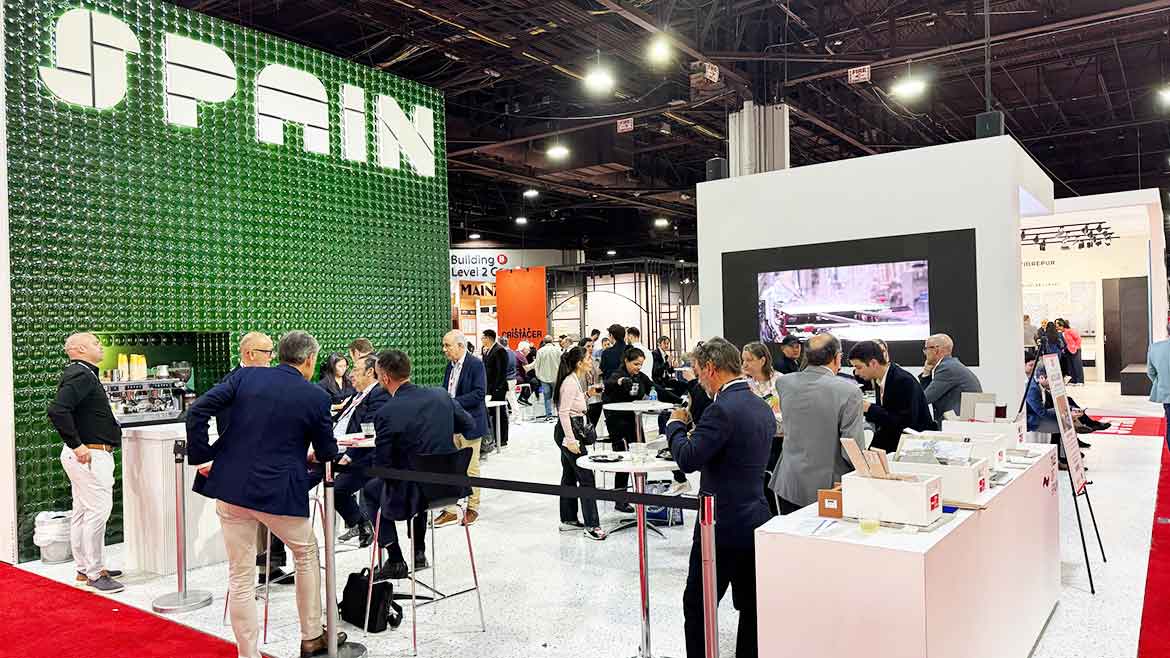
Rubio is very involved in the planning and supervising of the Tile of Spain Pavilion at Coverings, which always draws a crowd. For the 2024 exhibition, which recently took place in Atlanta, GA, the booth had a new look. Photo courtesy of Tile of Spain USA
S&TI: Tell us a little about your current role with the Trade Commission.
RR: My current role is director of the department of ceramic tile, natural stone, building materials and furnishings at the Trade Commission of Spain.
My main roles and responsibilities include the planning and coordination of promotional activities across multiple sectors, including ceramic tile, natural stone, wood flooring, windows and doors, and kitchen and bath, for both residential and commercial markets. Overseeing and managing Tile of Spain, the program that promotes awareness of Spanish ceramic tile in the U.S. is the most prominent role of my responsibilities.
I also devote a lot of time to market research and analysis to facilitate and assist Spanish companies navigate U.S. distribution and retail channels with the intent to forge connections with product specifiers.
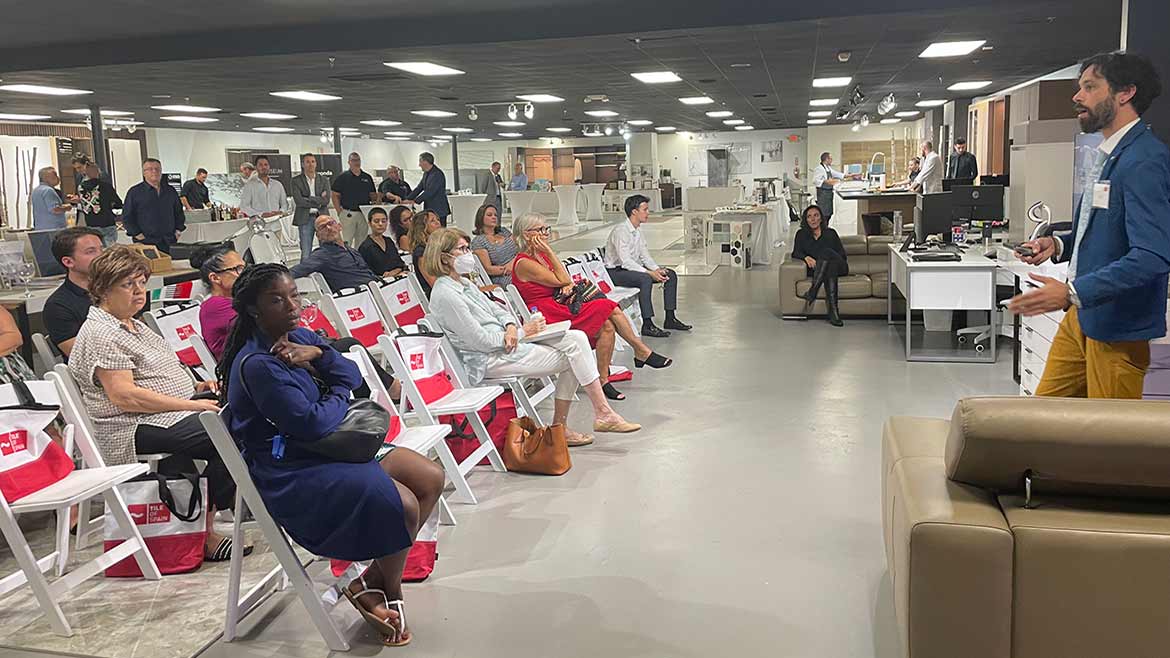
“Many years ago, I had the privilege of working with Patti Fasan, a notable industry professional, to make Tile of Spain an AIA continuing education provider, and later we also accredited Tile of Spain with IDCEC with the goal to educate interior designers,” said Rubio. Photo courtesy of Tile of Spain USA
S&TI: Among your duties, you work to introduce and promote Spanish tile to the A&D communities in the U.S. What are some ways you are doing this?
RR: Through the Tile of Spain program, we carry out many activities to promote the use of ceramic tiles for a variety of users. The A&D community is one of the most important and key to introducing Spanish ceramics to the market. It is a product that is reliable, sustainable and durable, as well as beautiful and the best option in any given environment for the end user.
I am particularly proud of the work I have done for A&D professionals in the U.S., primarily through education. Many years ago, I had the privilege of working with Patti Fasan, a notable industry professional, to make Tile of Spain an AIA continuing education provider, and later we also accredited Tile of Spain with IDCEC with the goal to educate interior designers.
Since then, we have organized seminars, workshops and presentations in many cities throughout the U.S. to inform architects and interior designers about new technologies, innovations and trends in ceramic tile.
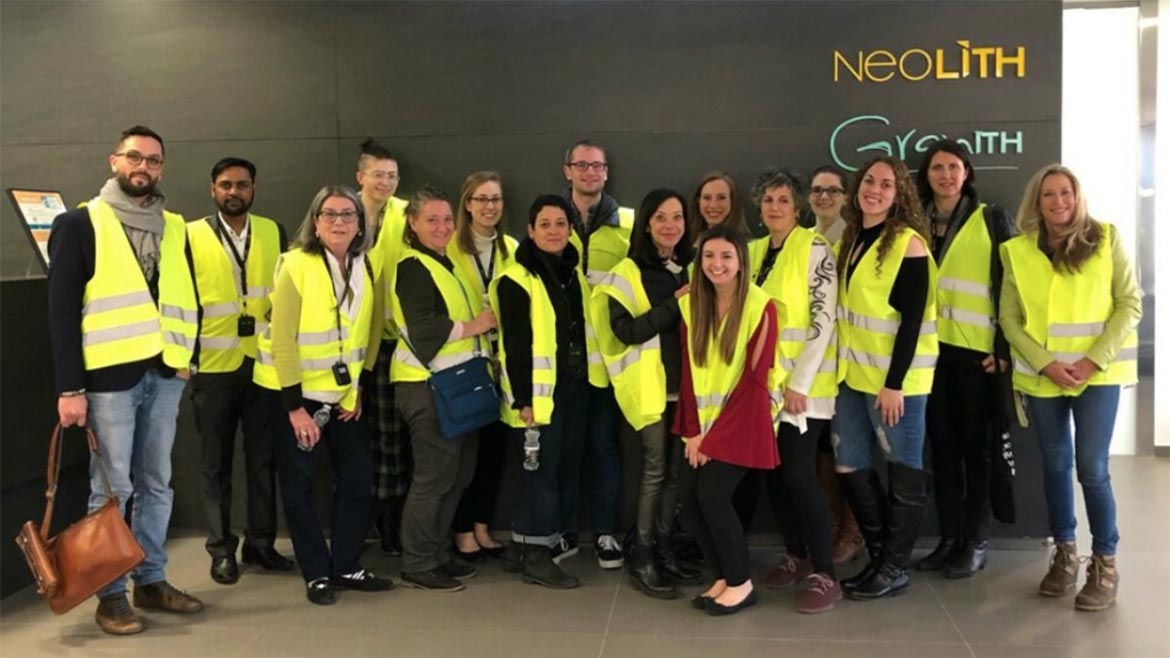
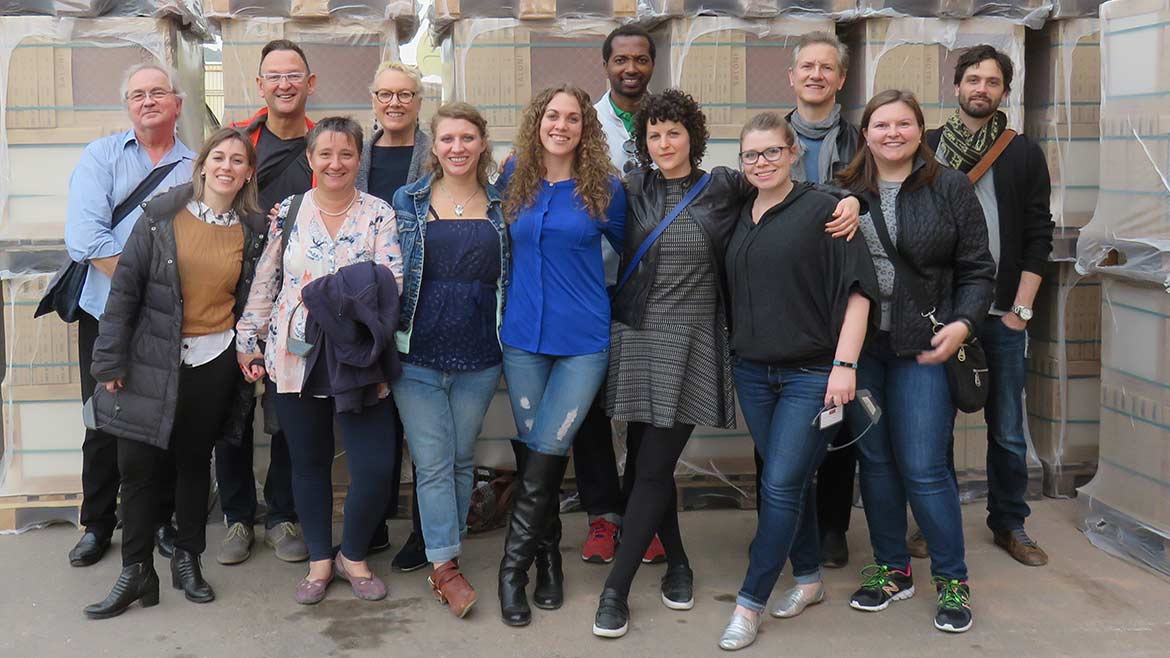
“The Passport to Creativity trip has been one of the most important and rewarding programs I developed during my time in this role,” said Rubio. Photo courtesy of Tile of Spain USA
S&TI: The Passport to Creativity Tour has been a successful way to emerge several architects and designers each year into the world of Spanish tile and culture. How did this idea first come about and how has it evolved through the years?
RR: The Passport to Creativity Tour is a great initiative I implemented years ago. At the beginning it was just the annual trip to visit the Cevisama trade show in Valencia, Spain, with a group of journalists. Over the course of a few days, we visited the fair, toured factories and the trip was a great immersion into the ceramic tile industry. Participants were able to see firsthand the ceramic tile novelties and the manufacturing process.
I always thought that just the show wasn’t enough. We were missing a key element that I think it is very important when you are not just trying to sell a product, but also want to share your culture and history. In Spain, ceramic tile has been around even before the Romans. In modern history we have not only Gaudi, but many great architectural projects through which ceramic tile can be shown.
I approached my headquarters in Madrid with the proposal to increase our budget to add two to three additional days to the trip. That’s when we started calling the trip the Passport to Creativity Tour. Over the years we have visited Madrid, Toledo, Seville, Granada, Bilbao, San Sebastian, Rioja, Barcelona, Mallorca, Malaga and Alicante, to name a few.
A few years later, we decided to expand our guest list and include a number of A&D professionals on the trip. But we didn’t want to pick and choose who was going to participate. Instead, we took the approach of asking architects and interior designers why they wanted to learn about ceramic tile and dedicate a week of their busy professional lives to come with us to Spain. This was a way to engage the community and find out a little bit more about their needs.
Year over year the trip continues to evolve. It has become one of the most successful and highly sought-after initiatives, not only within our yearly programming, but within the design community. The Passport to Creativity trip has been one of the most important and rewarding programs I developed during my time in this role.
S&TI: What do you like most about what you do?
RR: It is not strictly related to ceramic tile or any other sector I’m involved in at the Trade Commission, but one of the things that I like most about what I do is the training and mentoring of the young interns who join my department each year. Since my years in Brazil, I have been responsible for teaching around 100 interns, and every year they prove to be great contributors to what we do in market analysis, trade shows, promotional events, social media, etc.
I keep in contact with many of them even after their time with our organization is complete. It makes me proud to see how some of my interns have developed into great professionals in different industries all over the world.
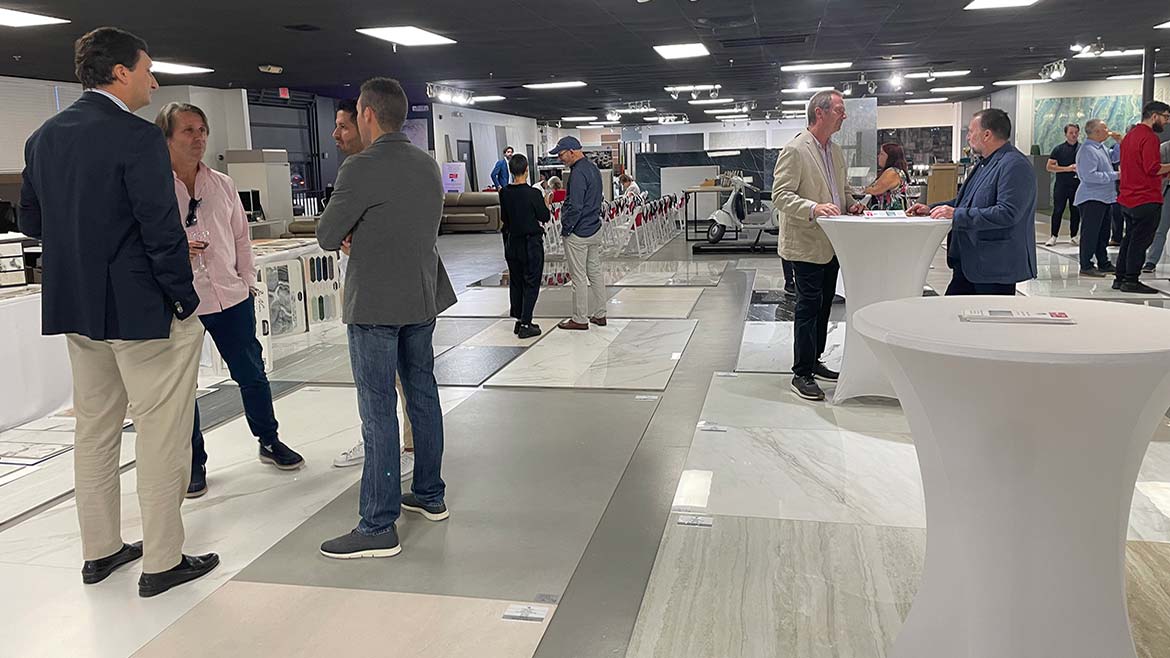
Tile of Spain USA has organized CEU learning sessions across the country, including this one in Miami, FL. Photo courtesy of Tile of Spain USA
S&TI: What are some challenges you face in your mission to promote Spanish tile in the U.S. and what are some ways to problem solve to hurdle these obstacles?
RR: The biggest challenge I have faced in promoting Spanish tile in this market is the size and scope of the U.S. and not being able to reach everyone I would like to.
Having strong professionals to collaborate with and develop marketing strategies and educational programs has been a great help; Looking back, I think we have accomplished a lot.
S&TI: Are there some current initiatives you are working on that you would like to share?
RR: Right now, there's a project I am working on that I’m really excited about. I can't give too many details because it's still in the works, however, through our Consulates in the area, we are helping the City of New Orleans restore and recover some of the original Spanish ceramic street signs. One of our Tile of Spain companies, ADEX, is working on replicating these signs. I hope to be able to share more details soon, as it is a beautiful project.
I’m also focusing on a lot of training programs. There are so many products coming into the market that are completely different from what was sold 10 years ago. Education and training at all levels is essential.
S&TI: Through the years, more women have entered the tile industry in various roles. A Women in Tile group has even recently been formed. As a woman in the industry for so many years, have you noticed this shift, and if so, how has it affected you?
RR: Indeed, it’s great to see that more women are, not just involved, in the ceramic tile industry, but also recognized for the impact they have and for the roles they play. Not only are we seeing more women in the industry, we are seeing women creating their own companies and being key players in the decision-making process.
I know about the NTCA [National Tile Contractors Association] Women in Tile group. That’s an organization that really speaks to me and one I would like to get more involved with.
S&TI: What is one of your most memorable experiences or something you are most proud of in regards to working in the tile industry?
RR: How to answer…I’d have to say it’s all of the people I’ve had the privilege of working with through the years. I have had the opportunity to meet and work with many great professionals from around the world, including manufacturers, distributors, journalists, specifiers and influencers. It is a tough and very competitive industry, but also one filled with great people.
As I mentioned earlier, the Passport to Creativity trip to Spain also brings to mind many memorable and impactful moments I am very proud of.







.jpg?height=200&t=1711504513&width=200)
